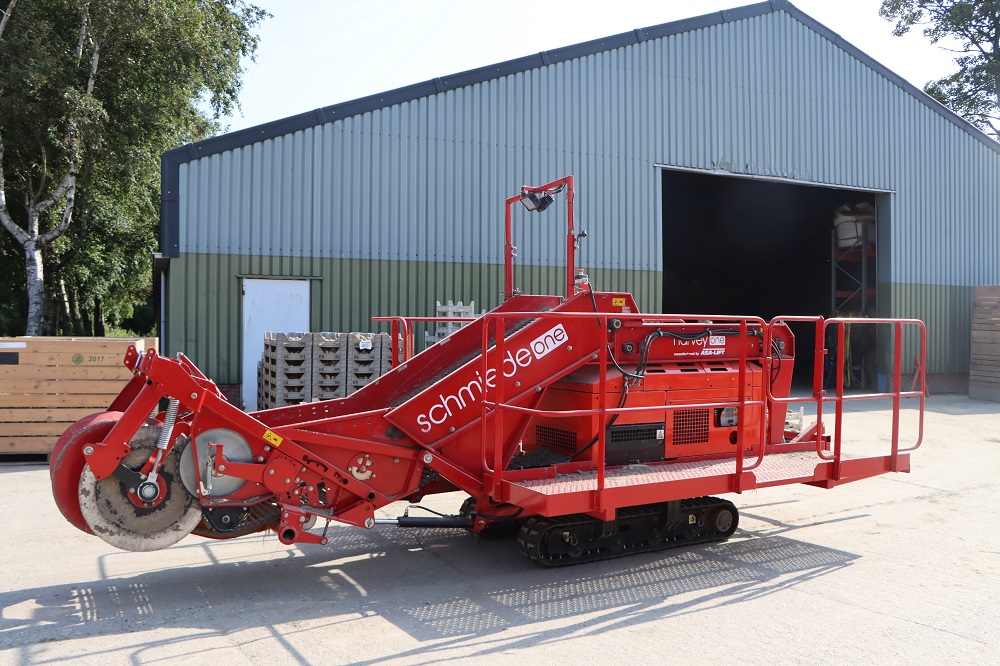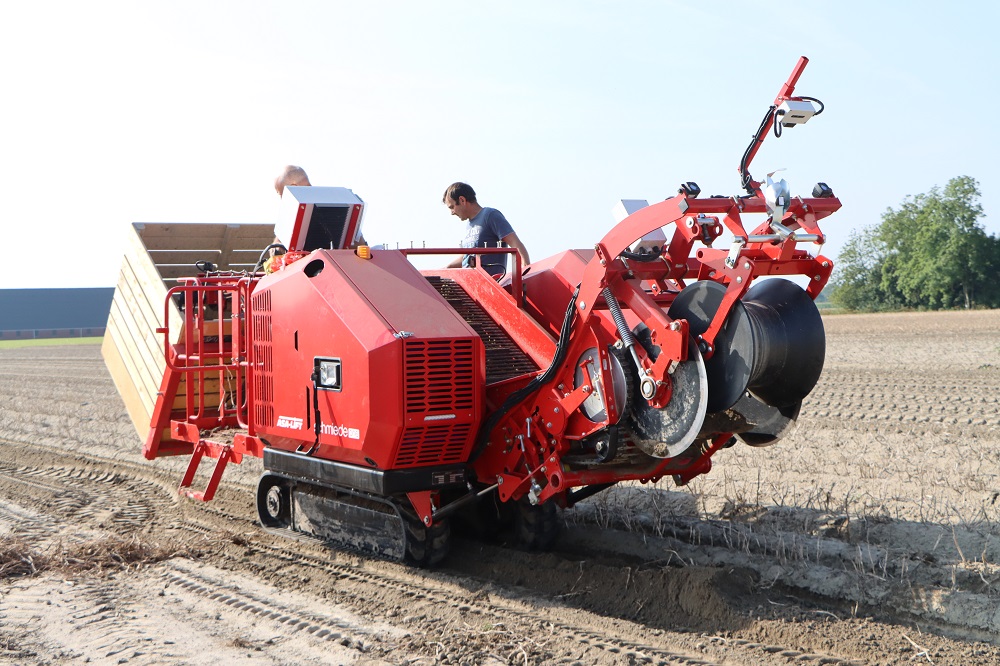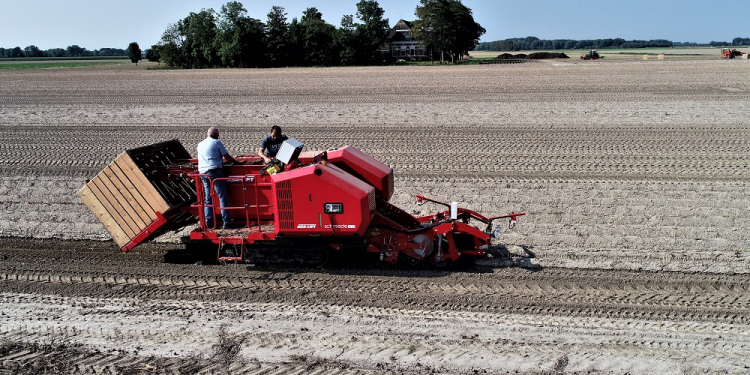The world’s first autonomous potato harvester, called the Harvey.One, is bright red, has a caterpillar undercarriage and drives completely independently with two employees on the sorting platform who operate the remote control silently over the Groningen countryside. Meanwhile, the potatoes are picked up and sorted into crates. “We are very happy with it and very excited about what the Harvey.One has harvested so far. After the first test season in 2020, we submitted a number of wishes to the developer,” says Roelof Sloots of potato propagation company Sloots Agri.

“These adjustments, such as improvements including the placement of the engine, hydraulics and cooling, are now separate from each other. That’s better for weight distribution. The controls have also become more accurate.”
School students replaced by Harvey.One
Until 2020, Sloots Agri always had about twelve students turn up in the summer to harvest potatoes manually for three weeks. That happened in Eenrum (Groningen). Sloots Agri manages 210 hectares there where seed potatoes, sugar beet, seed onions and winter wheat are grown. “But the students did not always do the work as desired. They often left the good potatoes. In addition, it became increasingly difficult for us to find employees who wanted to sit with their knees in the clay for three weeks to harvest the potatoes in good but also bad weather conditions. We would like to decide for ourselves and check the potatoes before they are sorted.”
Schmiede.One
Schmiede.One is the developer of the Harvey.One harvester and is a sister company of the Grimme group. The software engineers at the development company mainly think ‘out of the box’. The first model was shown at Agritechnica 2019. At the time, it was mainly focused on the harvest of sweet potatoes, a cultivation that is on the rise. Sloot Agri then contacted mechanization company Van der Maar Mechanisatie to investigate whether testing this machine was possible. Together with Grimme, ASA-LIFT, Schmiede.One, the study model was further developed in just two years into an autonomous harvester that is ready for practice.

Economical on the fertile soil
Sloots Agri is very careful with the precious soil where the world’s best seed potatoes are grown. “We are dealing here with eighteen percent slip-resistant loam soil that we do not want to spoil. The soil must remain nice and loose and can be harvested for a good yield and high quality potatoes”. Sloots Agri also wishes to expand the breeding company and wants to test more numbers of starting plants. This should ensure the development of new potato varieties.
Reduction of working capital by the Harvey.One
“Every year we start with 60,000 new genetically different plants that we want to reduce to one percent in about five years. I think that with the use of this autonomous harvester, we will practically get the expansion we have planned. The Harvey.One offers peace of mind at work and is a significant reduction in working capital. Now we control what I had to share with temporary workers in the past.
The harvesting speed of the Harvey.One depends on the harvesting conditions and the size of the lots. Now we are working on propagation that also includes the mother tubers. I think we are at an average speed of two kilometers per hour. When the tops of the potatoes are dead, you can harvest more quickly,” says Sloots.
Suitable for potatoes but also vegetables
“Growers increasingly prefer light machines and are taking more account of the soil conditions. At first we thought that the autonomous harvester is only suitable for harvesting sweet potatoes. However, after two test seasons, we discovered that it is suitable for sweet and seed potatoes as well as for various vegetables,” says Jan Bouma (representative at Grimme).
Cameras detect on harvester whether they are on the field or at the head end. The cameras are also able to recognize the potatoes. We are not doing anything with it yet, but we want to work towards a 3D camera that recognizes the potato. He can then calculate the weight and then measure the yield. As long as the correct yield measurement is still missing, we cannot yet spread the correct amount of fertilizer and apply crop protection products.
A seed potato grower is interested in the number of tubers and size sorting. In the future, cameras can also be used with robotic arms to sort clods or wrong potatoes. We expect to be able to market approximately three to five units a year of the Harvey.one in the Benelux.”
Technical details
- Single row semi-autonomous harvester, developed in 2018 through a collaboration between ASA-LIFT and Schmiede.one. Improvements have been made after extensive field testing, including at Sloots Agri.
- – Caterpillar tracks (Caterpillar) 1994 mm length, for low ground pressure (1994 mm length)
- – Equipped with an autopilot
- – Programmable stopping points
- – Automatic depth control
- – Adjustable functions
- – Remote control and touchscreen control terminal
- – 90 l fuel tank
- – 41 kW @ 2600 rpm Doosan diesel engine
- – configurable sorting belts and loading options for large boxes or vegetable trays (max. 1,000 kg)
- – sorting platform for up to four people
- – width 2350 mm, length 7100 mm
- – turning circle: 6 m
- Price: from 100,000 euros
- Suitable for the harvest of sweet and seed potatoes, onions, turnips, carrots. A 75 centimeter wide harvesting channel together with a caterpillar undercarriage and various options makes the machine possible for harvesting different crops.
Text and image: Annelies Bakker
This is an article from the Akkerbouwkrant .


